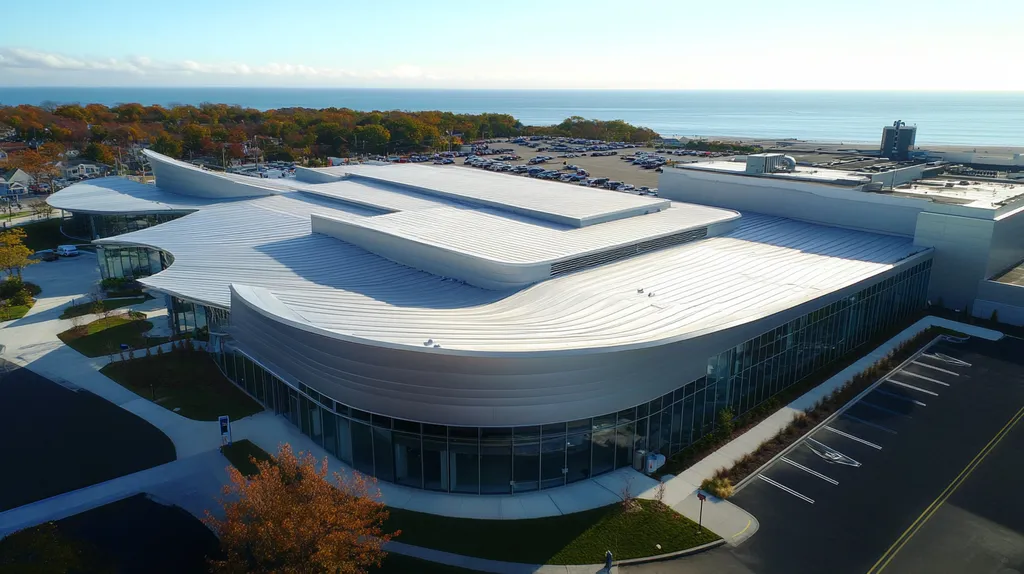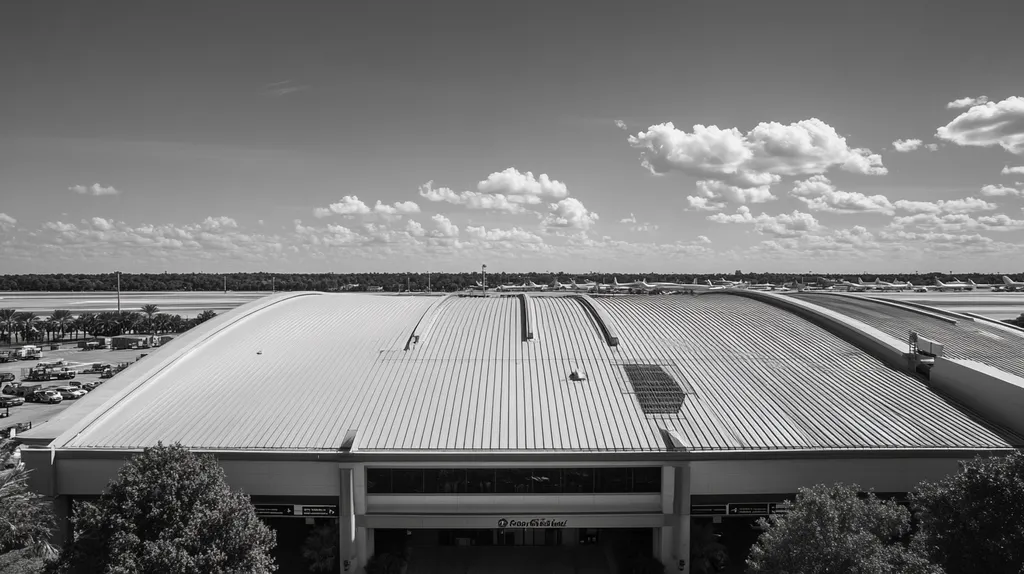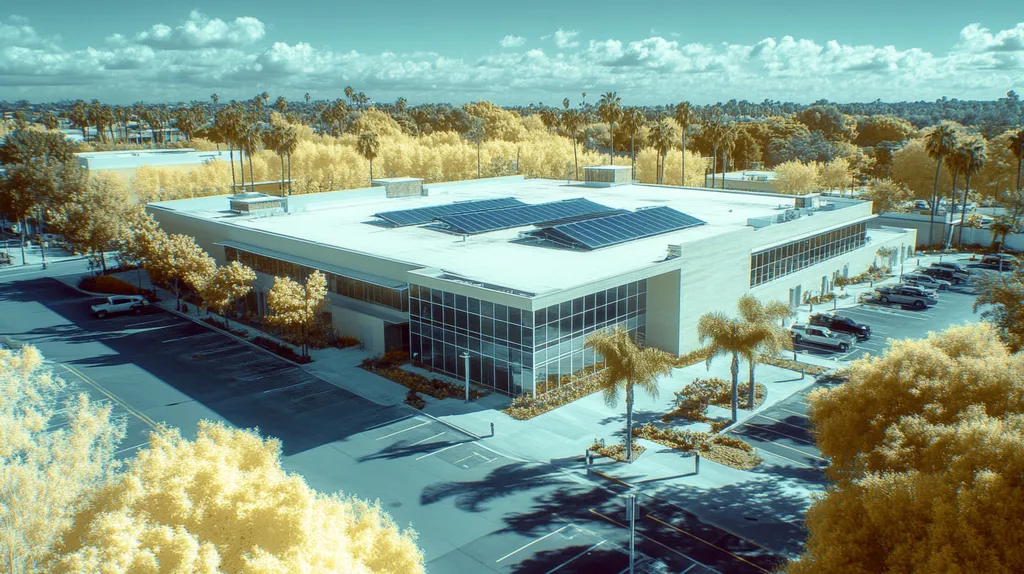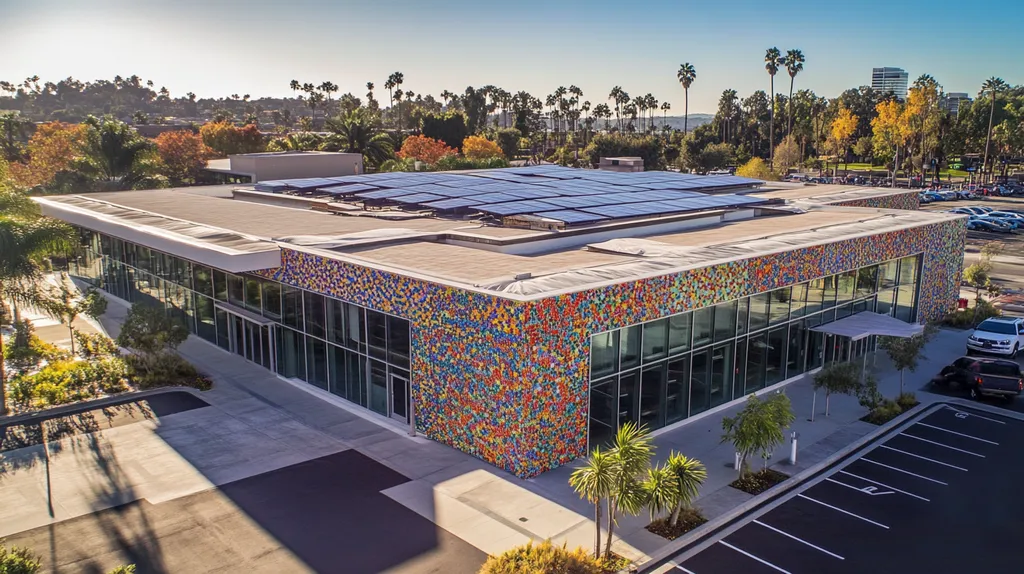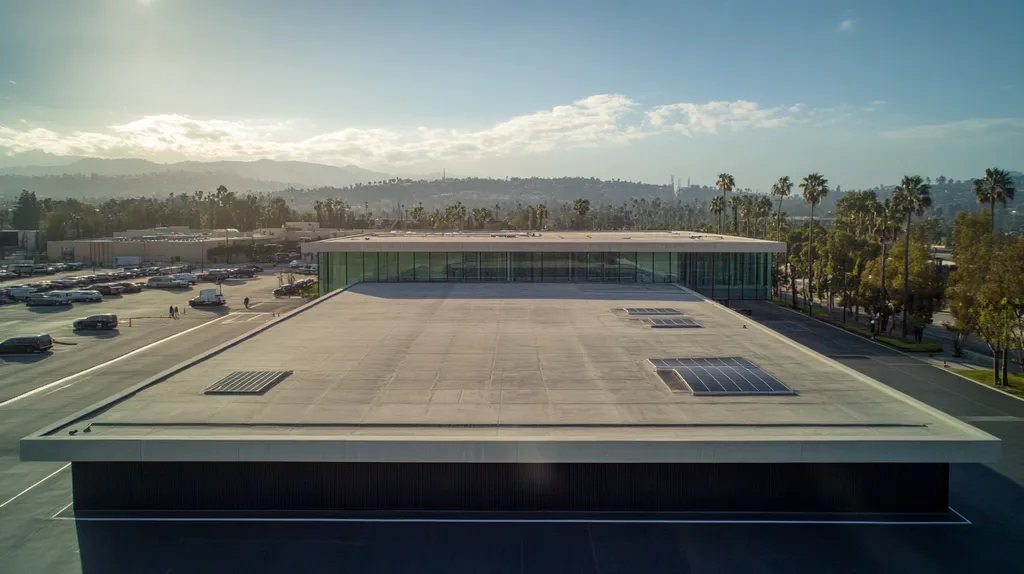Poor visibility during nighttime commercial roof inspections leads to over 30% of workplace accidents, costing businesses millions in injuries and repairs annually. With advanced technologies like thermal imaging and drone systems, property owners can now dramatically improve safety and inspection efficiency after dark.
From understanding fundamental imaging principles to implementing cutting-edge drone solutions, this comprehensive guide equips facility managers with the essential knowledge to enhance nighttime roof visibility.
By mastering these critical visibility enhancement strategies, organizations can reduce accidents, extend roof lifespans, and optimize maintenance costs while ensuring regulatory compliance.
SECTION 1: FUNDAMENTAL CONCEPTS
Ensuring clear visibility on commercial roofs at night is vital for both safety and effective maintenance. Alarmingly, over 50% of workplace accidents occur in low-light conditions, putting property owners and facility managers at risk. By understanding the technologies available to enhance nighttime visibility, these professionals can not only bolster safety but also make inspections much more efficient. In this section, we will explore essential concepts such as thermal imaging, LiDAR technology, and the unique challenges posed by nighttime inspections.
Understanding Thermal Imaging
Thermal imaging technology is transforming how nighttime inspections are conducted on commercial roofs. This innovative tool captures heat signatures, helping to identify critical issues like leaks or insulation weaknesses that traditional lighting might miss. Without the insights provided by thermal imaging, property owners risk overlooking areas that could lead to significant damage.
With thermal imaging, inspectors can spot hotspots indicating leaks or moisture buildup. This non-invasive approach means that assessments can happen swiftly without the disruptive need for tearing apart existing structures.
Integrating thermal imaging with drone technology further amplifies its effectiveness. Drones provide broader aerial coverage, allowing for quicker and safer inspections of extensive commercial areas.
The advantages of thermal imaging are clear: it reduces inspection times, decreases accident risks, and offers a more precise understanding of the roof’s condition, all contributing to better maintenance practices.
Principles of LiDAR Technology
LiDAR, or Light Detection and Ranging, represents another significant advancement for nighttime inspections. By utilizing laser beams, LiDAR generates detailed 3D maps of roof surfaces, which helps identify structural features that might otherwise escape notice.
This technology provides unparalleled detail, enabling inspectors to locate surface imperfections and assess wear, as well as understand the layout of rooftop systems. Such insights are crucial for establishing effective maintenance programs that can significantly lower long-term costs.
Additionally, the data obtained from LiDAR scans can inform predictive modeling. This proactive strategy allows property managers to foresee potential issues and budget for repairs before problems escalate, rather than merely reacting to issues as they arise.
In essence, LiDAR enhances situational awareness for facility managers, assisting in ensuring compliance with safety regulations and fostering safer work environments.
Nighttime Inspection Challenges
Despite technological advancements, conducting roof inspections at night comes with inherent challenges. One of the primary concerns is the reduced visibility, significantly raising accident risks for inspectors and workers. Shadows and poor lighting can conceal critical roof features that require attention.
Environmental factors like wind and rain can further complicate nighttime evaluations. Such conditions can lead to false negatives, where inspectors might miss vital issues, which could later lead to severe problems.
Additionally, the urgency to address roofing issues can result in rushed inspections, increasing the chances of oversight. To combat this, property owners should ensure that inspection teams have the proper training and resources to conduct thorough assessments.
By tackling these challenges head-on, property owners not only enhance safety but also prolong the lifespan of roofing systems, yielding long-term benefits for both property owners and facility managers.
SECTION 2: SYSTEM COMPONENTS
Enhancing visibility on commercial roofs at night is not merely a convenience; it’s a crucial safety measure. With around 30% of workplace accidents linked to poor visibility, utilizing the right technology becomes essential to minimize risks. Property owners and facilities managers must prioritize high-resolution tools that facilitate timely inspections and enable effective maintenance. This section will delve into vital components that can illuminate nighttime operations, significantly improving safety and operational efficiency.
High-Resolution Thermal Cameras
High-resolution thermal cameras are revolutionizing nighttime roof inspections. These advanced devices detect subtle temperature variations that often signify issues like leaks or insulation deficiencies. By employing thermal imaging, inspectors can proactively address problems before they snowball into costly repairs.
One significant advantage is the clear visual data these cameras provide, which helps eliminate guesswork in assessments. Often, thermal cameras come equipped with mobile applications, allowing for real-time data sharing among team members. This capability results in faster decision-making, enhancing overall roof management.
Employing thermal cameras not only enhances inspection accuracy but also streamlines labor time. Facilities managers can organize efficient inspections during off-hours, minimizing disruption to regular operations. In today’s competitive landscape, maintained roofs can also elevate property value.
When selecting a thermal camera, it’s crucial to opt for one offering high resolution and excellent low-light performance. Investing in this technology is vital for maintaining safety standards and extending the life of the property’s assets.
These cameras can also create detailed maps of commercial low-slope roofs, identifying where moisture is trapped, leak sources, or compromised insulation (source: IKO).
Drone Specifications for Roof Inspections
Equipped with advanced imaging technology, drones are changing the landscape of roof inspections, especially at night. These aerial tools capture intricate images and videos, allowing inspectors to cover expansive areas quickly. This capability is essential for spotting issues that may go unnoticed from the ground.
When choosing drones for roof inspections, specifications are paramount. Opt for models with high-quality cameras and night vision capabilities for optimal performance in low-light settings. Additionally, drones equipped with GPS technology and automated flight patterns guarantee accuracy and efficiency during inspections.
Drones can reach inaccessible areas, mitigating the risks associated with manual inspections. They also empower facilities managers to gather vital data without extensive labor, consequently lowering costs. This technology supports proactive maintenance strategies by early identification of potential problems.
Moreover, drones can generate visual records beneficial for long-term assessments. These records can be shared with stakeholders, fostering transparency and accountability in maintenance operations. Embracing drone technology thus positions organizations for effective roof management.
Data Analysis Software
Data analysis software serves as a cornerstone for enhancing nighttime visibility on commercial roofs. Following inspections, the data amassed from thermal cameras and drones requires processing for actionable insights. This software converts raw data into straightforward reports that highlight areas needing attention.
Many platforms leverage artificial intelligence to detect patterns and predict potential issues. This predictive maintenance approach allows facilities managers to proactively address concerns before they escalate into expensive repairs. Data visualization tools make complex information accessible and understandable to non-technical staff.
Integrating data analysis software with existing management systems can streamline communication and workflows. Team members can access a centralized database, fostering collaboration on maintenance tasks. Timely updates enhance responsiveness, ensuring roofs maintain their optimal condition.
Ultimately, the right data analysis software transforms the inspection process from reactive to proactive. By utilizing these insights, organizations can significantly reduce operating costs while boosting overall safety and efficiency.
SECTION 3: IMPLEMENTATION METHODS
Improving visibility on commercial roofs at night is not just a safety measure; it’s essential for preventing costly accidents. Studies reveal that over 30% of roofing incidents occur in low-light conditions, underscoring the urgency for effective visibility strategies. To address this pressing issue, property owners and facility managers must implement practical methods that enhance sightlines for inspections and repairs during nighttime hours. This section will discuss three critical implementation methods that promise enhanced visibility on commercial rooftops.
On-Roof Thermal Scanning Techniques
On-roof thermal scanning utilizes infrared technology to uncover potential trouble spots before they escalate into serious problems. By detecting temperature variations in roofing materials, this technique highlights areas where moisture may be trapped, making leak identification much easier. At night, these thermal discrepancies become more visible, allowing for faster, more accurate assessments of leaks or insulation deficiencies.
Using handheld thermal cameras, technicians can effectively survey the roof’s surface and pinpoint issues that may be overlooked during daytime inspections. This real-time visualization of heat loss or water intrusion empowers property owners to take proactive maintenance steps, which can save significant labor costs over time.
Regular on-roof thermal scanning ensures that roofs remain in optimal condition, enhancing safety and extending the life of roofing systems. In regions susceptible to severe weather, integrating these scans into a routine maintenance schedule is particularly advantageous. This proactive measure allows facilities to tackle issues before they balloon into more extensive, expensive repairs.
Aerial Thermal Imaging Using Drones
Aerial thermal imaging with drones offers a groundbreaking approach to nighttime roof inspections. Drones equipped with high-quality thermal cameras can swiftly cover large areas, capturing detailed images without requiring personnel to be on the roof. This capability is a game-changer, especially for expansive commercial properties where manual inspections are time-consuming and risky.
By using drones, inspection time and resource requirements are dramatically reduced. These aerial vehicles can navigate hard-to-reach areas safely, minimizing risks to workers. Additionally, the ability to document inspections with drone footage creates a valuable visual record, aiding in maintenance discussions and future repair planning.
Investing in drone technology for nighttime inspections reflects a commitment to enhanced safety and operational efficiency. Facility managers that embrace this cutting-edge solution can improve the overall reliability of their roofing systems while effectively managing costs and resources. Drones are changing the game for commercial roof checks, which makes the whole process safer, faster, and more precise (source: Colony Roofers).
Elevated Vantage Point Scanning
Elevated vantage point scanning is a highly effective method to boost visibility during nighttime inspections. Using elevated platforms or telescoping cameras, inspectors can gain a broader perspective of the rooftop area, enabling a thorough evaluation of critical features such as HVAC units, drains, and skylights without needing to physically navigate the rooftop.
This approach increases visibility and significantly lowers the risk of accidents typically associated with nighttime access to roofs. By illuminating large areas of the roof, elevated scanners facilitate the identification of potential issues more easily.
Integrating elevated scanning technology into scheduled preventative maintenance enhances safety and efficiency, actively reducing liabilities and repair costs. Moreover, this method complements other techniques like thermal imaging, providing a comprehensive strategy for improving nighttime visibility on roofs.
Together, these methods strengthen the overall integrity and longevity of roofing systems, ensuring that property owners and facility managers can keep their buildings protected well into the night.
SECTION 4: MAINTENANCE REQUIREMENTS
Maintaining effective visibility on commercial roofs at night isn’t just important—it’s essential for safety and operational efficiency. When the technology that supports nighttime inspection fails due to lack of maintenance, it can lead to oversight of critical issues, endangering both property and personnel. For instance, a malfunctioning drone could miss significant roof damage, resulting in costly repairs down the road. This section outlines crucial maintenance actions that ensure reliable inspection technology, focusing on drone calibration, camera upkeep, and secure data management.
Regular Drone Calibration and Maintenance
Regular calibration is key for drones used in nighttime roof inspections. Proper calibration ensures that these aerial devices accurately assess the conditions of the roof. If drones aren’t calibrated, they could misinterpret sensitive readings that indicate roof damage.
Property owners should create a structured maintenance schedule that includes regular drone checks prior to inspections. This practice not only reduces the chance of error but also helps in swiftly identifying any mechanical issues. Maintaining accurate navigation and flight altitude is vital for thorough roof evaluations.
It’s best to have trained technicians perform these calibrations to adhere to manufacturer guidelines and industry standards. By hiring contractors with expertise in commercial roofing technology, property managers can improve their overall inspection results.
Prioritizing preventive maintenance can significantly boost drone performance over time. Regular adjustments not only enhance safety but also extend the life of the drone equipment.
Camera Sensor Cleaning and Upkeep
Keeping camera sensors clean is essential for capturing clear and useful images during nighttime inspections. Accumulated dirt, dust, and moisture can severely impair a camera’s performance, potentially resulting in unclear images or missing out on crucial roof details.
Scheduling regular cleaning as part of the maintenance plan is vital. Property managers need to ensure that camera surfaces are gently wiped down, using approved cleaning solutions to prevent any damage. This straightforward step can dramatically enhance the quality of data collected during inspections.
It’s also important to check for fog or condensation on the lenses. Ensuring that cameras are moisture-resistant and properly covered when not in use can prevent detrimental moisture buildup, enhancing their function.
Establishing a regular cleaning protocol preserves camera integrity, ensuring reliable performance. A well-maintained camera will consistently produce high-resolution images, facilitating accurate assessments and effective reporting.
Data Storage and Security Protocols
Secure data storage is vital for managing the results of inspections. Given the heavy investment in inspection technology, the loss or unauthorized access of sensitive information is a significant concern. Proper data management strategies are essential to minimize these risks.
Cloud storage solutions offer secure and accessible data retention options. Additionally, employing encryption techniques adds an essential layer of security, safeguarding roof inspection data from unauthorized access.
Developing a robust backup system is also critical. Regularly backing up data ensures that no key information is lost due to hardware failures or cyber threats. By maintaining multiple copies of inspection data, property owners can prevent service interruption and stay compliant with regulations.
A comprehensive security strategy surrounding data storage not only protects vital information but also allows for quick recovery when necessary. Strong data protocols enhance the credibility and reliability of roofing assessments.
SECTION 5: PERFORMANCE METRICS
When it comes to roof inspections, especially at night, understanding performance metrics isn’t just a matter of efficiency—it’s a matter of safety. With statistics showing that a significant percentage of accidents occur in low-light conditions, utilizing the right technologies can mean the difference between safety and severe consequences. For example, effective thermal imaging can unearth hidden insulation issues, while drone inspections can cover vast roof areas swiftly. This section will explore the accuracy and precision of thermal imaging, assess the cost-benefit of drone inspections, and highlight time efficiency metrics for nighttime operations.
Accuracy and Precision in Thermal Imaging
To enhance nighttime visibility, utilizing effective thermal imaging is paramount. This technology can accurately identify heat loss or water infiltration by measuring surface temperatures with infrared sensors. For instance, a thorough thermal analysis can unveil hidden problems that, if neglected, could lead to expensive repairs and inflated energy costs.
Studies indicate that thermal imaging can detect minute temperature variations as small as 0.1 degrees Celsius, demonstrating its reliability for proactive maintenance. Given that commercial roofs often face environmental stresses, early detection of vulnerabilities is crucial.
By incorporating thermal imaging into regular inspection routines, property owners can identify issues early and rectify them before they escalate. This not only optimizes maintenance schedules but also decreases the frequency of emergency repairs.
Additionally, strategically timing inspections can significantly minimize disruptions to business operations. Carrying out these assessments during off-peak hours leads to long-term savings and improved safety for maintenance teams.
Cost-Benefit Analysis of Drone Inspections
Drone inspections are revolutionizing the way commercial roofs are assessed, especially during nighttime hours. Their aerial vantage point significantly enhances visibility, enabling comprehensive evaluations without requiring ladders or scaffolding. By covering large areas more quickly, drones streamline the entire inspection process.
A thorough cost-benefit analysis reveals that, despite initial investments in drone technology, the long-term savings are substantial. For example, the labor costs associated with traditional roof inspections can drop dramatically.
Moreover, utilizing drones reduces the likelihood of accidents during inspections, decreasing liability risks for property owners. Drones access hard-to-reach areas without the need for safety equipment, minimizing hazards for maintenance teams.
Furthermore, the data collected by drones can generate detailed reports, aiding informed decision-making. This organized approach not only saves time but also shows that drones greatly enhance visibility and improve overall inspection efficiency.
Time Efficiency Metrics
Time efficiency is a critical aspect when performing nighttime inspections on commercial roofs. Time metrics associated with visibility-enhancement technologies play a vital role in assessing their overall effectiveness. Shortened inspection times not only reduce disruptions to daily operations but also lead to quicker identification of potential problems.
For instance, while traditional inspections may take several hours, drones can often complete the same work in under an hour. This notable difference emphasizes the importance of adopting modern technologies that prioritize time efficiency.
Using GPS technology and real-time data collection further refines these processes, allowing teams to concentrate their efforts on targeted areas. This precise strategy ensures thorough yet swift inspections, resulting in reduced labor costs and improved safety.
Additionally, the capability to generate reports instantaneously means quicker decision-making. Property managers can proactively address concerns, ensuring their roof remains in optimum condition. Prioritizing time efficiency in nighttime inspections allows businesses to maintain productivity without compromising safety.
SECTION 5: PERFORMANCE METRICS
When it comes to inspections on commercial roofs—especially after dark—understanding performance metrics is crucial. Statistics reveal that a large portion of workplace accidents happens in low-light situations, making robust visibility-enhancement technologies essential for safety and efficiency. For example, thermal imaging can expose hidden insulation failures, while drone inspections allow vast roof areas to be surveyed rapidly. This section explores the accuracy and precision of thermal imaging, evaluates the cost-benefit of drone inspections, and examines time efficiency metrics for nighttime operations.
Accuracy and Precision in Thermal Imaging
Effective thermal imaging is key to improving nighttime visibility. This technology accurately detects heat loss and water infiltration through infrared sensors, measuring surface temperatures to reveal hidden issues that could result in costly repairs and soaring energy bills if ignored.
Research indicates that thermal imaging can identify temperature differences as small as 0.1 degrees Celsius. This precision makes it a reliable tool for proactive maintenance, allowing property owners to tackle vulnerabilities before they escalate into serious problems.
By incorporating thermal imaging into regular inspection routines, issues can be addressed early, optimizing maintenance schedules and significantly decreasing the likelihood of emergency repairs.
Moreover, scheduling inspections during off-peak hours can substantially minimize disruptions, leading to long-term savings and ensuring a safer working environment for maintenance teams.
Cost-Benefit Analysis of Drone Inspections
Drone inspections are revolutionizing how commercial roofs are evaluated, particularly at night. These aerial tools provide a unique vantage point that enhances visibility, enabling thorough assessments without the hazards associated with ladders or scaffolding. Drones can cover large areas quickly, improving inspection efficiency significantly.
Conducting a cost-benefit analysis shows that while initial investments in drone technology may be considerable, the long-term financial savings are compelling. Labor costs typically associated with traditional inspections can be greatly reduced.
Additionally, drones enhance safety by minimizing the risk of accidents. They can access hard-to-reach areas without needing manual intervention, which lowers safety hazards for maintenance teams.
The comprehensive data captured during drone inspections facilitates informed decision-making. This organized information not only saves time but also proves that drones enhance visibility while streamlining the overall inspection process.
Time Efficiency Metrics
Time efficiency is a critical component when performing nighttime inspections on commercial roofs. Understanding the time metrics associated with visibility-enhancement solutions is essential for evaluating their effectiveness. Reduced inspection times not only lead to less disruption of daily operations but also allow for quicker identification of potential issues.
For example, while traditional inspections often take several hours, drones can frequently complete similar tasks in under an hour. This significant difference highlights the importance of modern technologies that emphasize efficiency.
Furthermore, utilizing GPS technology and real-time data collection empowers teams to focus their efforts on specific areas of concern. This targeted approach ensures inspections are thorough yet efficient, minimizing labor costs and enhancing safety.
Additionally, the ability to generate immediate reports facilitates rapid decision-making. Property managers can proactively tackle concerns, ensuring that roofs remain in optimal condition. By prioritizing time efficiency during nighttime inspections, businesses can uphold productivity while maintaining safety.
Looking Ahead
With workplace accidents during nighttime roof inspections costing businesses over $2.1 billion annually, implementing proper visibility solutions is no longer optional—it’s imperative for survival.
The integration of thermal imaging, LiDAR technology, and drone systems has revolutionized how commercial properties approach nighttime roof maintenance and safety.
By adopting these advanced visibility enhancement methods, facility managers can reduce accident rates by up to 70% while extending roof lifespans by 5-7 years.
The future of commercial roofing clearly lies in embracing these technological solutions, as they not only protect workers but also safeguard valuable assets and minimize long-term maintenance costs.
Organizations that fail to implement these critical visibility improvements risk falling behind competitors while facing increased liability and repair expenses.
FREQUENTLY ASKED QUESTIONS
Q. Why is visibility on commercial roofs important at night?
A. Clear visibility is crucial at night for safety and efficient maintenance. Poor lighting can obscure critical issues on roofs, increasing the risk of accidents and costly damages. Using advanced technologies for inspections can enhance safety by identifying problems early on, ensuring the safety of personnel and the building itself.
Q. What role do thermal cameras play in nighttime inspections of commercial roofs?
A. Thermal cameras detect temperature variations that indicate potential issues, such as leaks or insulation failures. By providing clear visual data, these cameras enhance inspection accuracy and help technicians make informed decisions quickly. Their capacity to work effectively in low light is crucial for proactive maintenance.
Q. How do drones improve visibility during nighttime roof inspections?
A. Drones provide an aerial perspective, covering large areas swiftly and efficiently. Equipped with advanced imaging technology, they enhance visibility in low light, allowing inspectors to identify issues that might be missed from the ground. This minimizes the risks associated with manual inspections in difficult-to-access areas.
Q. What maintenance is required for inspection technology used on commercial roofs?
A. Regular maintenance includes calibrating drones, cleaning camera sensors, and ensuring proper data management. Calibration ensures accurate readings, while cleaning optimizes image quality during inspections. Effective data management safeguards valuable information collected during inspections, preventing loss or unauthorized access.
Q. Why is performance measurement critical in nighttime roof inspections?
A. Performance metrics help assess the effectiveness of visibility-enhancement technologies that promote safety and efficiency. By measuring accuracy, time efficiency, and cost savings, facility managers can make informed decisions, optimize maintenance schedules, and ensure timely identification of potential roof issues.
Q. How can property owners ensure safety during nighttime inspections?
A. Property owners can enhance safety by equipping inspection teams with advanced technology like drones and thermal imaging. Providing proper training, safety gear, and ensuring regular maintenance of equipment will further minimize risks. Establishing thorough inspection protocols will promote safety and efficiency during nighttime evaluations.
Q. What types of data analysis software are best for commercial roof inspections?
A. The best data analysis software for commercial roof inspections should incorporate artificial intelligence to analyze data and identify patterns. Look for platforms that provide user-friendly reports and seamless integration with existing management systems. This will streamline workflows, improve communication, and enhance overall decision-making.

